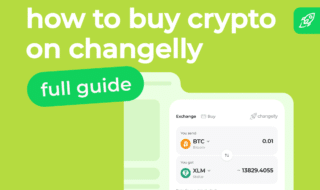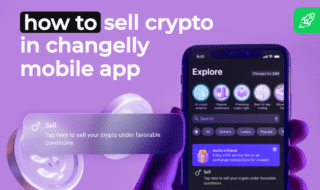Is this your first time exchanging cryptocurrency or using Changelly? Then you’ve come to the right place! In this guide, we will take a look at how you can get crypto on our platform and also explain the key things you need to know to navigate the cryptocurrency market.
Table of Contents
What Is Cryptocurrency?
Cryptocurrency is a decentralized digital asset. But what does this mean?
To put it simply, it does not rely on nor can it be governed by any central authority, such as a government or a private company. It does not have a physical form, and is instead stored on blockchains — digital ledgers.*
This technology allows crypto users to make peer-to-peer transactions, meaning there are no third parties involved when people send cryptocurrencies to one another. Crypto transactions are direct and trustless.
*Because of this, you cannot store cryptocurrencies on your debit or credit card, and will need to use a crypto wallet instead.
What Is a Crypto Wallet?
A crypto wallet is a key part of the cryptocurrency ecosystem. In a way, it can be seen as your “bank account” in the world of cryptocurrencies — after all, that’s where you store your digital currency. However, there are some important differences between crypto wallets and bank accounts. Let’s explore some of them.
First of all, crypto wallets do not store stacks of digital currencies. Instead, they keep your public and private keys* — something that is required for you to make any operations with the crypto you own. Cryptocurrencies themselves are stored on blockchains. Crypto wallets also provide digital signatures that are needed to authorize crypto transactions.
*Public keys can be seen as something similar to a bank account number, while the private key is like your PIN — something that should be kept secret.
On the surface, crypto wallets provide a nice user-friendly interface that allows you to interact with your cryptocurrency. You can view your balance, send your crypto, or even exchange it all within one app.
All wallets can be divided into two big categories: custodial and non-custodial. The first category, custodial, refers to wallets that have control over users’ private keys and, therefore, have full control over user funds. The most common example of custodial wallets is exchange wallets — the in-built storage available on many major exchanges, like Binance.
Non-custodial wallets, on the other hand, do not hold users’ private keys. They can be divided into two big groups: cold and hot wallets.
Hot Wallet
A hot wallet is a cryptocurrency wallet that is always connected to the Internet. Because of this, such wallets tend to be more convenient to use but are more vulnerable to hacks and other criminal attacks.
Hot wallets come in many forms: they can be a mobile app, a browser extension, a desktop application, or an exchange wallet — a storage solution built into an exchange platform.
One of the defining features of all hot wallets is their ease of use and user-friendliness. Many of them offer additional features, such as in-wallet exchanges and crypto purchases.
Some examples of hot crypto wallets include MetaMask, Exodus, and others.
Cold Wallet
Unlike hot wallets, cold wallets are disconnected from the Internet. This makes them incredibly secure and thus perfect for storing bigger amounts of cryptocurrency.
However, the higher level of security comes at a cost, both literally and figuratively. Cold wallets aren’t free — they can cost anywhere from $70 to $150. Additionally, they aren’t as easy or intuitive as hot wallets. Although most cold wallets these days have dedicated apps that enable users to interact with their wallets on their PCs or mobile devices, they can still feel a little awkward to use.
If you’re looking for a good cold wallet, check out the models that Ledger and Trezor have to offer.
How to Choose a Suitable Wallet
Choosing a suitable crypto wallet comes down to your preferences. Although cold wallets are more secure, if you’re just starting out, it can be a good idea to get a hot wallet first as it will be free and easy to download. Just make sure that your chosen wallet supports the cryptocurrency you want to get.
Hot wallets are also more suited for making smaller but more regular transactions, while cold wallets are great for holding large amounts of crypto for longer periods of time.
Most hot wallets are pretty similar, and your final choice will depend on what features you need above all else. Do you like simplicity, or would you rather have a lot of features to play around with? Additionally, think about the kinds of cryptocurrencies you would like to get. For example, a crypto wallet like MetaMask is more suited for getting Ethereum and Ethereum tokens, but not Bitcoin.
Remember that since most crypto wallets are free, you can download as many of them as you want and see which one you like best. However, before you transfer your crypto to it, make sure that your chosen wallet has good reviews and has not been involved in any hacks or scams.
Key Features of Cryptocurrency
All cryptocurrencies can be characterized by the same set of features. Here they are:
- Anonymous. Crypto transactions are never tied to anyone’s personal data.
- Trustless. There are no intermediaries involved.
- Decentralized. There are no authorities controlling the flow of crypto.
- Immutable. Once data is recorded onto the blockchain, it cannot be changed. This means that crypto transactions are irreversible.*
*This is why it’s so important to never send crypto to wallet addresses you don’t know or were given by a person or entity you don’t trust — you won’t be able to get your funds back. Beware of scammers!
Different Types of Cryptocurrencies
Although, just like traditional – fiat — money, cryptocurrency can be used to pay for goods and services, many cryptos have other use cases.
Before we go any further, it’s worth noting the distinction between tokens and coins. The latter are the cryptocurrencies that operate on their own blockchains, like Bitcoin. The former instead use other blockchains — for example, Ethereum is a very popular blockchain for token development. Tokens typically perform some sort of function in a specific project, while coins perform the more traditional currency roles of storing value and being used as a payment method.
Please note that tokens can operate on multiple different blockchains at the same time. However, token A on a blockchain XYZ and blockchain NVM cannot be used interchangeably, and has to be stored separately. Although some platforms support cross-chain transactions, ours hasn’t introduced this feature yet. Unless it is explicitly stated that cross-chain exchanges are supported, you should always assume they aren’t available. When exchanging tokens, make sure to pay attention to what network type (blockchain) they belong to.

Here are some different types of cryptocurrencies that you may have heard of:
- Stablecoins — cryptocurrencies that are pegged to another asset or group of assets. Their value pretty much always hovers around the same amount, like $1. Some examples include USDT and USDC.
- Altcoins — all cryptocurrencies other than Bitcoin.
- Meme coins — these cryptocurrencies typically perform no functions and only exist for speculative purposes. However, they often develop strong communities, which allows them to stay strong for long periods of time. Some examples are Dogecoin and Shiba Inu.
- Shitcoins — this is a name used to describe cryptocurrencies with little to no value… at least, in terms of price. These coins can sometimes have huge rallies, giving their holders astronomical profits.
This is, of course, not everything cryptocurrencies have to offer. Our market is a rapidly growing and incredibly innovative one, so new projects appear every day. To keep up with the latest crypto market news, you can follow our Twitter account or subscribe to our email newsletter.
From Zero
to Crypto Hero
Learn crypto basics in 25 minutes with Pickle. Plus, grab a $100 bonus to start swapping smarter



What You Need to Exchange Cryptocurrency
In order to exchange cryptocurrency, you will first need to own some. There are multiple ways to get cryptocurrency, like airdrops, faucets, mining, and so on. However, the easiest way to get your hands on some crypto is by buying it. You can follow our step-by-step guide on how to buy crypto coins and tokens on Changelly here.
When you go to buy cryptocurrency, you will be asked to enter your crypto wallet address. Don’t worry, you don’t need to spend any money to get one — many crypto wallets are completely free.
Please note that no matter if you’re buying crypto or exchanging it, you should only ever enter your own crypto wallet address or the address of someone you know well and trust in the “Recipient address” field. Don’t send crypto to people you don’t know, especially if they promised you “insane profits” or help with your investments.
Another thing you will need is a reliable crypto exchange platform. If you’re a beginner, Changelly will be a great choice for you. We offer low fees and competitive rates and have over 500 cryptocurrencies available for exchange.
Some crypto wallets allow you to exchange cryptocurrency without having to leave the app — for example, Exodus or Trezor.
What Is Changelly?
Changelly is a beginner-friendly cryptocurrency exchange that has been operating since 2015. We offer over 500 cryptocurrencies and always keep listing new interesting projects. Although this guide is all about crypto exchanges, we also offer other features.
How Does Changelly Work?
Changelly gives users a complete crypto experience: on our platform, you can buy, sell, and exchange crypto all at the same great rates and for low fees.
If you are looking to buy cryptocurrency, you can check out our fiat-to-crypto marketplace — it also works as an aggregator. We are partnered with several providers that you can choose from depending on your preferred payment method, fiat currency, and rate.
Recently, we’ve also launched our own DeFi Swap — a decentralized exchange aggregator that allows our users to interact with and exchange even more tokens at the best rates we can find across different platforms.
Advantages of Using Changelly
- 24/7 live support in a wide variety of languages
- No need to create an account
- Fair and competitive rates
- High level of security
- We do not store any of your funds or personal information
- Low fees
How to Exchange Crypto on Changelly
Exchanging crypto on Changelly is very easy, and won’t take you much time.
What Are Rates? How Are They Calculated?
The exchange rate is the price — rate — at which one unit of a cryptocurrency can be exchanged for a unit of another cryptocurrency. It is not any cryptocurrency’s price in USD or any other fiat currency.
On Changelly, the exchange rate is displayed below the “You send” field. It looks like this:

These rates are then used to display an estimation of the sum you will have received by the end of the exchange. Please note that due to the volatile nature of the crypto market, as well as fees not being set in stone, either, this estimation might change during the exchange process.
Please note that fees are typically calculated in the cryptocurrency you want to spend — send to us. If you’re sending a token, for example, Uniswap (UNI), the fees will be calculated in the main cryptocurrency of the blockchain the token belongs to — in the case of UNI, that will be Ethereum.
For our users’ convenience, we offer two types of rates: fixed and floating.
Floating Rates
Floating rates are the option that will be chosen by default. This type of rate represents the best offer available in the market at that particular time. This means that the rate you see when creating a floating rate transaction is the market rate at that moment — but the market rate at which your transaction will actually be carried out might be different.
It is important to understand that crypto transactions are not instantaneous — they take some time to be completed, and during this time, the rate of the exchange can change. Since the crypto market is incredibly volatile, that change can be quite drastic. When you choose floating rates, you confirm that you will be OK if the transaction is carried out at the best possible rate at the moment when your payment to our wallet receives the required number of blockchain confirmations, and that that rate might differ from the one you agreed to.
Fixed Rates
Fixed rates aim to protect you from the volatility of the crypto market. They allow you to lock the rate you see when initiating the transaction. The rate you see will be the rate you get.
This option requires you to send us your funds within 15 minutes. If we receive less than the required amount* or if you don’t send the funds within that time frame, we will have to either
- push the transaction through if the rate hasn’t deviated too much (this is decided on a case-by-case basis)
- or issue a refund to the refund address you provided when starting the transaction. The network fee for the refund transaction will be deducted from the sum you originally sent us.
*Please note that your crypto wallet will charge an additional network fee when you send your funds to us — make sure the sum you’re sending covers that fee.
Step-by-step Process of Exchanging Crypto at Floating Rates
- Go to the Exchange tab on changelly.com and select the two cryptocurrencies you wish to exchange. Then, enter the amount you are going to spend and press the “Exchange now” button. Floating rates will be chosen by default.
- You will be transferred to the next page. Here, you can view all your fees*, which are included in the transaction amount, as well as transaction details. You will also need to enter your crypto wallet address in the “Recipient address” field. Please note that this is the wallet that your new cryptocurrency will be sent to — so it has to support the crypto you want to get, including the network type. Don’t forget to enter any extra IDs (e.g., Memo) if your wallet requires it. Additionally, make sure you or someone you can fully trust has access to that wallet.
- Tick the “I agree to Terms and Conditions” box and click the “Next step” button to proceed.
- Check your transaction details and click the Confirm button to proceed with your payment.
- You will be shown the amount you must send us and the wallet address to which you must send it. Go to your crypto wallet, choose the Send Crypto option, and either enter our wallet address manually or scan the provided QR code. Don’t forget to enter any extra ID (e.g., Memo) if it is required. Please note that for floating rate transactions, the wallet address we give you is only valid for the amount of time displayed on the payment page (usually 3 hours). Do not attempt to send funds to that address past this time frame!
- Please note that your wallet will charge a network fee for your transaction. Make sure that they do not get subtracted from the amount you send us, as then the exchange won’t go through. Please note that all ERC20 tokens require you to have a positive ETH balance because their fees get paid in Ethereum.
- In some cases, you might be asked to go through the verification process — KYC. Learn more about it here.
- Once that’s done, you will be redirected to a page where you can view your transaction status. The transaction will typically take somewhere between 5 to 40 minutes.
*This includes the exchange and the network fee for the payout transaction (the transaction we use to send funds to you). It doesn’t include the fee charged by your wallet when you send your funds to us.
If you have any questions, feel free to contact our 24/7 support team.
Step-by-step Process of Exchanging Crypto at Fixed Rates
- Go to the Exchange tab on changelly.com and pick the “Fixed rate” option on the widget. Pick the cryptocurrencies you wish to exchange, enter the amount you’d like to spend, and press the “Exchange now” button to proceed. Please note that not all cryptocurrencies are available for fixed-rate exchanges.
- Since this is a fixed-rate exchange, you will need to enter two wallet addresses. The first one is a recipient address — that’s the wallet where your new funds will be sent. The other one is the refund address — this one should support the cryptocurrency you will send to us. It will be used for automatic refunds if the exchange doesn’t go through.
- Tick the “I agree to Terms and Conditions” box and click the “Next step” button to proceed.
- Confirm the transaction details and click the Confirm button to proceed.
- Send the exact amount we require to the provided wallet address. To send crypto, open the wallet where you store the cryptocurrency you wish to send us, choose the Send Crypto option, and either enter our address manually or scan the provided QR code.
- Please note that your wallet will charge a network fee for your transaction. Make sure that they do not get subtracted from the amount you send us, as then the exchange won’t go through.
- You have to send the funds as soon as possible — we will give you a time frame, and you should send the cryptocurrency within it. In most cases, it is 15 or 20 minutes. Do not send cryptocurrency to our wallet past that time frame. Please note that all our wallet addresses can only be used once. If you’ve used it more than once or sent crypto to our wallet too late, please contact our support team (and don’t forget to mention your transaction hash) as soon as possible.
- In some cases, you might be asked to go through the verification process — KYC. Learn more about it here.
- Once that’s done, you will be redirected to a page where you can view your transaction status.
FAQ
Overview of potential issues and how to avoid them
There are some common issues you may encounter when exchanging crypto on Changelly (or any exchange, really). Here are some of them — and tips on how you can avoid them.
- Not entering Memo.ID. If your or our wallet requires a Memo.ID like a Memo, Destination Tag (XRP), or Message (XEM), make sure to enter it in the designated field. And if Memo.ID isn’t required, make sure to leave this field blank — otherwise, our platform won’t be able to process your transaction automatically. If you’ve entered something in the Memo.ID field by mistake or left it empty when you were not supposed to, please contact our support team ASAP.
- Not sending us enough crypto. Make sure that the amount you send us includes any additional fees that might be charged by your wallet.
- Low amount. You can check the minimum amount for any crypto pair by entering 0 in the “You send” field. Please note that this number is dynamic, and you should use a bigger amount than the one shown as a minimum.* Additionally, make sure you send the whole sum in one singular transaction.
- Sending crypto to our wallet address more than once or too late. Please note that our wallet addresses are all for one-time use: they expire within the time specified on the payment page that you see during the transaction process.
- Choosing the wrong network type. Some tokens are available on different networks — make sure the networks of tokens you both send and receive match the networks supported by your crypto wallet and, even more importantly, match the network type supported by our platform and the one you chose during the exchange. If you send funds via the wrong network, they will most likely be lost. In some rare cases, we might be able to refund them, but it will take a really long time, and we will have to subtract the network fee and the fee for retrieving the funds from the refund amount.
You can learn more about our refund policy in this article. Please contact our support team right away with your transaction hash if your transaction fails for any reason.
*If you send us the minimum amount or a slightly smaller one, please contact our support team — they will try to help you.
How long do cryptocurrency transactions take?
The amount of time it will take for a new crypto to reach your wallet depends on various factors. An average crypto transaction takes anywhere between 10 and 15 minutes, but that can sometimes be extended — or shortened. Please note that our ETAs do not include the time it takes to get the necessary blockchain confirmations.
The platform where we’ll be exchanging your funds might require more confirmations than the number displayed in the blockchain explorer. So, if you see Success in your hash, it might not necessarily mean that after that, the transaction will switch to the processing stage. It may take a little longer — and for some currencies, more than a little. Please pay attention to the notifications we show during processing to find out if the confirmation process for a certain currency might take a long time.
Here are some of the factors that affect how long transactions take. These factors are outside of our control and impact the time it takes to obtain the necessary blockchain confirmations, not the actual transaction process we are responsible for.
- Cryptocurrency type. Some cryptocurrencies and blockchains take longer to be transferred. Things like block time, congestion, number of confirmations, and more can all impact transaction speed. Please note that the number of confirmations required to qualify your transaction as valid in the blockchain explorer might differ from the one actually needed to carry out the transaction. Pay attention to the notifications we display during the transaction process — we will warn you if the transaction might take longer than expected.
- Fee size. The higher the network fees you pay while sending funds from your wallet, the sooner your transaction will reach our system and the sooner we will be able to begin the exchange process. Although some crypto wallets set fee sizes automatically, some also let you choose what kind of network fee you want to pay. Please note that if you enter/select a small fee size, your funds will take a very long time to arrive.
- Network congestion. If there are a lot of people trying to make transactions at the same time, transaction speed will naturally slow down. This is why you should be cautious when making transactions during rallies — with many users trying to get the same crypto simultaneously, your transaction time will increase, and you will be subjected to higher volatility.
If we predict that the transaction is going to take a long time, we will notify you on the processing screen. Please keep an eye on notifications like that and read them carefully.
Tips and best practices for exchanging cryptocurrency on Changelly
- First things first, make sure to read all the tooltips and instructions we provide very carefully. They’re there to help you. Particularly, pay close attention to the notifications we might send you during the transaction process — for example, we might notify you that network confirmations are taking longer than expected.
- Always carefully check all transaction details before confirming anything, especially wallet addresses, rates, and fees. It’s better to be safe than sorry.
- Make sure to check if your crypto wallet or ours (the one you send money to) requires a Memo.ID. This is very important — if it is required, the transaction will not go through without it.
- Always check if the amount we receive from you actually equals the one we’re asking for. If your crypto wallet subtracts network fees from the amount you send us, you must include them in the amount.
- Make sure the wallet address you enter in the recipient address field matches the network type and the ticker of the cryptocurrency you chose in the “You get” field. If there is a mismatch, your funds might be lost. In some cases, two (or more) cryptocurrencies might have the same ticker — if you aren’t sure which one you should select, please contact our support team.
How do I scan the QR code if I’m using the app?
If you’re exchanging crypto within the Changelly app, you can screenshot the QR code we provide you with. When you go to scan the QR code within your wallet, you can open your gallery and scan our QR code from the saved screenshot.
Does Changelly support RBF? Can I send a second transaction to the same Changelly wallet address?
RBF (replace-by-fee) is a special method available in crypto wallets. It allows users to replace a transaction with an unconfirmed transfer hash with its different version with a higher fee. This boosts the transaction and makes it faster. RBF results in the creation of two separate transaction hashes.
Changelly does not support RBF. As per our Terms of Use, all our crypto wallet addresses can only be used once. This means that each Changelly wallet address can only correspond to one transaction hash. Since RBF creates two separate transaction hashes, such operations will not be processed, and will require manual processing and the involvement of several different departments.
Please create a new transaction every time you want to send or resend us your crypto. We will give you a new one-time-use Changelly wallet address for every new transaction you make.
How do transaction fees work?
Let’s take a look at all the transaction fees you might pay during an average exchange on Changelly.
- Our service fee.
This fee doesn’t change and is always equal to 0.25% of the transaction amount. It is paid in the cryptocurrency you want to receive and included in the transaction amount.
- The network fee for the payout transaction.
This is the fee required to process the transaction that involves us sending your desired cryptocurrency to your wallet. It is paid in the cryptocurrency you will receive, and it is also included in the transaction amount. This is a flat fee. That means that the fee is fixed for a certain period of time and doesn’t depend on the transaction amount. For instance, you’ll be charged 5 BUSD no matter if you’re to receive 100 BUSD or 1,000 BUSD.
- The network fee for the transaction you send to us.
This is the fee needed to process the transaction that involves you sending your funds to us. It is paid in your crypto wallet, and it will either be added automatically to the required amount you need to send, automatically subtracted from your existing crypto wallet funds, or will have to be added manually by you to the amount you send us. This fee will depend on the cryptocurrency you will be sending to us — if it’s Bitcoin, it will be paid in BTC, if it’s an ERC20 token (like USDT20), it will be paid in ETH, and so on.
Please pay attention to what your wallet tells you and how it works. If the fee is subtracted from the transfer amount, then you should send us the amount that equals “the amount Changelly expects to receive from you + the network fee” so that after the subtraction, Changelly receives the exact amount you entered for the exchange.
Disclaimer: Please note that the contents of this article are not financial or investing advice. The information provided in this article is the author’s opinion only and should not be considered as offering trading or investing recommendations. We do not make any warranties about the completeness, reliability and accuracy of this information. The cryptocurrency market suffers from high volatility and occasional arbitrary movements. Any investor, trader, or regular crypto users should research multiple viewpoints and be familiar with all local regulations before committing to an investment.



